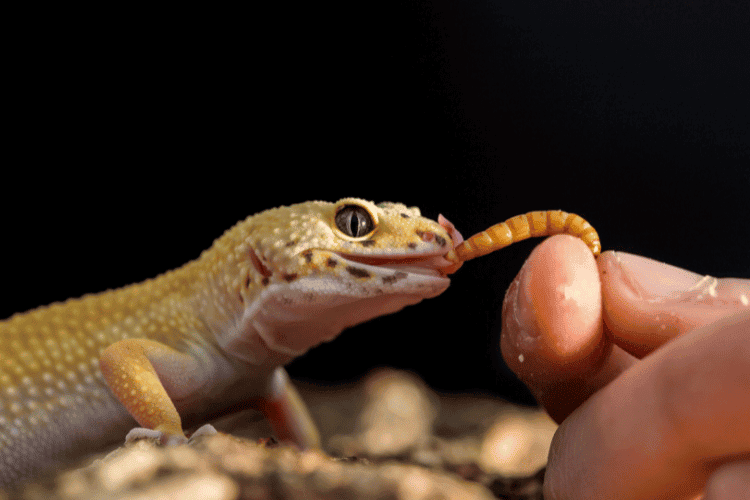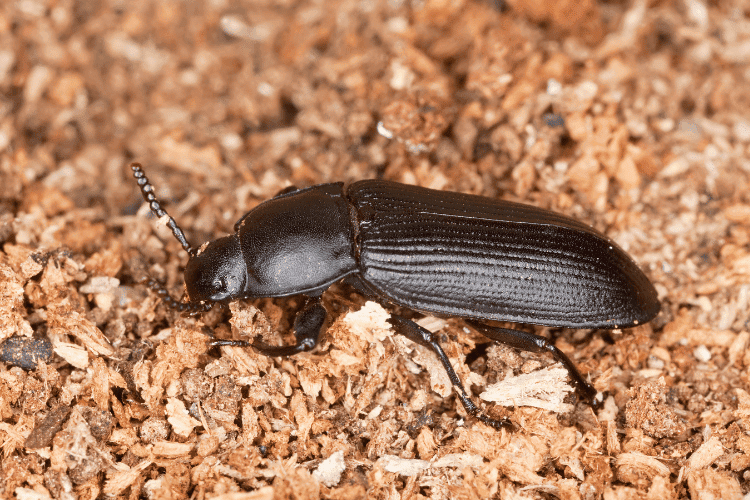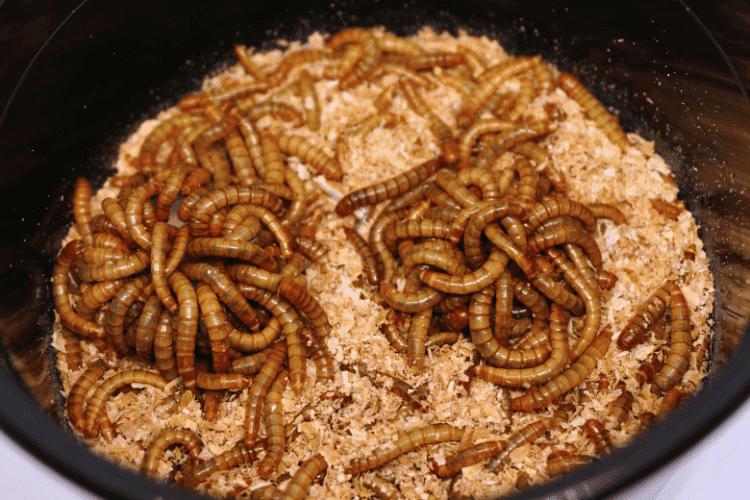
Leopard geckos are famous for their wide smiles and their endless appetite for insects. They seem to gulp on just anything you place on their plate. But are mealworms on the list? Can leopard geckos eat mealworm beetles?
And if they do, is it safe to feed them those beetles? It’s not like everything animals like to eat is safe, right? Let’s find out.
Do Leopard Geckos Like Mealworm Beetles?
Yes, leopard geckos can eat mealworm beetles. However, whether or not they will eat them depends on the individual gecko. Some geckos may find the beetle a bit tough to chew on compared to other insects such as crickets, while others will dive right in and munch away.
Mealworm beetles are an excellent source of protein and
A varied diet is important for leopard geckos, and their diet should consist of a variety of insects, such as crickets, mealworms, superworms, waxworms, and feeder roaches.
Is It Safe for Leopard Geckos to Eat Mealworm Beetles?
When considering the safety of incorporating mealworm beetles into your leopard gecko’s diet, several factors come into play. These insects can indeed be a valuable protein source, particularly for smaller or younger geckos. However, you should keep a few things in mind.
One concern lies in the potential for mealworm beetles to cause harm if they are significantly larger than the gecko or if the gecko is particularly small. Their hard exoskeletons may pose digestive issues or even lead to choking, especially for younger geckos.
Additionally, being cautious about how the gecko interacts with the beetles is vital. You don’t want your gecko to learn the hard way that biting a mealworm from its tail will backfire. The mealworms often turn around and bit into the gecko’s face, potentially hurting the eyes.
To address these concerns, it’s advisable to offer smaller portions of mealworms, especially for smaller geckos, and to consider softer alternatives like dubia roaches. Regular intervals for feeding and ensuring that the gecko is not overwhelmed by larger beetles can contribute to a safe feeding routine.
How to Feed Mealworm Beetles to Leopard Geckos?
Feeding mealworm beetles to leopard geckos requires careful consideration of their growth stage and dietary needs. By following a few guidelines, you can provide a balanced and safe feeding routine for these captivating reptilian companions.
Adult Leopard Geckos
For adult leopard geckos, a feeding regimen that offers variety and nutritional balance is crucial. A diet consisting of six to seven large crickets or mealworms two to three times a week is generally suitable.
However, ensure that mealworms are not the sole food source, as leopard geckos may become selective eaters, favoring certain insects and rejecting others.
Adding dietary supplements like wax worms or calciworms can enrich their nutritional intake while offering an occasional treat. Remember to prioritize
Juvenile Leopard Geckos
Juvenile leopard geckos have distinct dietary requirements during their growth phase. To foster their development, provide them with 8-10 small mealworms or five to six large worms per feeding.
An essential rule of thumb is to match the width of these worms with the distance between their eyes. This ensures an appropriate portion size and minimizes the risk of choking.
As they continue to grow, adjusting the portions and variety of insects will contribute to their overall health and vitality.
In both cases, hydration is key. Always offer fresh water in a shallow dish for your leopard gecko to access whenever they need it.
By tailoring their diet according to their growth stage and providing a diverse range of insects and supplements, you can help your leopard gecko thrive and lead a healthy and contented life.
How to Maximize the Nutritional Value of Mealworm Beetles?
To ensure that mealworm beetles are a nutrient-rich food source for your leopard geckos, there are several steps you can take.
Nutrient-Rich Diet
Enhancing the nutritional value of mealworm beetles begins with their diet. Gut-loading these insects with nutrient-dense foods is essential. Feed them a mix of finely chopped vegetables such as spinach, carrots, and sweet potatoes.
These vegetables provide essential vitamins and minerals that will be passed on to your leopard geckos when they consume the beetles. Additionally, incorporating oats into the mealworms’ diet can contribute to their overall nutritional content.
Breeder Care
Maintaining a proper environment for your mealworm beetle breeder is crucial. Ensure that the breeding container has the correct temperature and humidity levels to promote the rapid and healthy growth of the beetles.

A suitable environment encourages optimal breeding and egg production, resulting in a consistent supply of darkling beetles for your geckos.
How to Store Mealworm Beetles?
Properly storing mealworm beetles is essential to ensure their availability as a nutritious food source for your leopard geckos.
Depending on your needs, you can adopt specific strategies to keep the mealworms either warm and alive or cold and dormant.
Warm and Alive
When aiming to maintain mealworms in an active state, create a conducive environment by providing a temperature of around 70℉. Ensure that your containers are open and shallow, positioned about an inch above the substrate to prevent escapes. Utilize glass or plastic containers for easy cleaning.
Layer the mealworm tank with a 3-inch coating of mealworm maintainer substrate, serving both as bedding and nourishment.
These insects thrive on finely ground grains like oats, contributing to their growth and vitality. Spread the mealworms on the bedding to allow them to dig in, offering a larger container for ample movement. Remember to change the bedding weekly to maintain cleanliness.
Cold and Dormant
For a dormant state, storing mealworms at a cooler temperature of 45-50℉, such as in a refrigerator, will delay their transition into pupa and darkling beetles. This approach can be valuable when you wish to slow down their life cycle.
When storing mealworms in the refrigerator, ensure they are well-fed before refrigeration. Cold temperatures can cause dormancy, and mealworms may not eat or be active if chilled abruptly.
This can result in nutritional deficits or starvation. Stored in this manner, mealworms can be fed to your leopard gecko for up to 6 weeks.
How Often Can You Give Mealworm Beetles to Leopard Geckos?
You can give mealworm beetles to leopard geckos as an occasional treat, but they should not be the main staple of their diet. Mealworm beetles are high in fat and low in
The recommended frequency for feeding mealworm beetles to leopard geckos is once or twice a week. You can also offer them other insects, such as crickets, mealworms, and superworms, daily.
Here is a feeding schedule for leopard geckos:
- Babies: 2-3 small mealworms or 1-2 mealworm beetles every day
- Juveniles: 3-4 mealworms or 2 mealworm beetles every other day
- Adults: 5-6 mealworms or 3 mealworm beetles 2-3 times per week
How to Start a Mealworm Colony for Your Leo?

Establishing a mealworm colony to provide a steady supply of nutritious darkling beetles for your leopard geckos can be rewarding. Here’s how to get it done:
Getting Started
Start with around 500 regular mealworms rather than “super” mealworms, which could contain growth-inhibiting hormones. Opt for a hormone-free source to ensure the growth of fertile beetles.
Setting Up the Breeder Box
Prepare a smooth-sided container about the size of a shoebox, ideally made of plastic or glass. Ensure the lid fits securely and provides ventilation holes to prevent mold growth. Introduce bedding, such as finely ground cornmeal, to the container.
Creating a Suitable Environment
Place 3-inch chunks of veggies like carrots or sweet potatoes into the container as a food source. Replace the food every few days to prevent mold. Add a banana peel or apple slice for moisture.
Allowing Growth
Allow the container to remain undisturbed for several weeks, maintaining a temperature of 76°F-80°F and 70% humidity. The mealworms will undergo stages of growth, transitioning from larvae to pupae and eventually to adult beetles.
Managing Temperature and Moisture
Maintain the ideal temperature by using a ceramic
The Verdict
To sum up, your leopard gecko can safely eat mealworm beetles. However, they shouldn’t be their daily driver since they’re high in fat and can make your gecko too chubby.
Make sure that you have the mealworms safely stored (cold or warm) according to the consumption of your gecko. Don’t forget to gut load them to ensure maximum nutrition for your smiley crawlers.
Get more questions about leopard geckos? Check out our ultimate guide to caring for leopard geckos.



